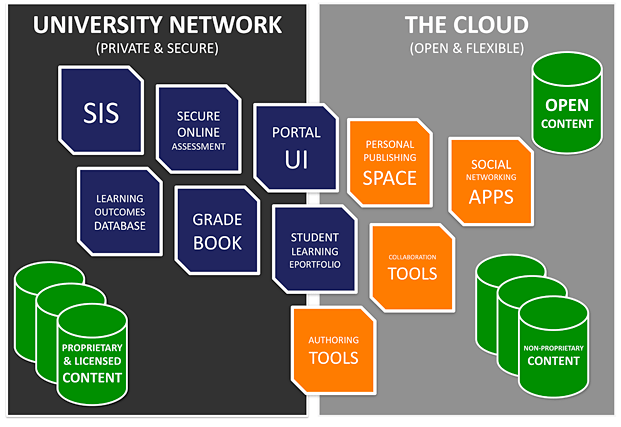Envisioning the post-LMS era: The Open Learning Network — from Educause Quarterly by Jonathan Mott
Learning management systems (LMSs) have dominated the teaching and learning landscape in higher education for the past decade,1 with a recent Delta Initiative report indicating that more than 90 percent of colleges and universities have a standardized, institutional LMS implementation.2 LMS-related decisions continue to rank among the most pressing IT issues for campus leaders and administrators, as explained in EDUCAUSE Review’s “Top-10 IT Issues, 2009,” which lists several challenges associated with LMS implementations, including:
- Acquisition strategies
- Adapting LMSs to local needs
- Managing rising costs
- Maintaining system stability and integrity
- Integrating LMSs with other campus tools and data3
While the LMS has become central to the business of colleges and universities, it has also become a symbol of the higher learning status quo. Many students, teachers, instructional technologists, and administrators consider the LMS too inflexible and are turning to the web for tools that support their everyday communication, productivity, and collaboration needs. Blogs, wikis, social networking sites, microblogging tools, and other web-based applications are supplanting the teaching and learning tools previously found only inside the LMS.
The dilemma thus created is succinctly summarized in the “Top-10” report:
Although the LMS needs to continue serving as an enterprise CMS [course/content management system], it also needs to be a student-centered application that gives students greater control over content and learning. Hence, there is continual pressure for the LMS to utilize and integrate with many of the Web 2.0 tools that students already use freely on the Internet and that they expect to find in this kind of system. Some educators even argue that the next requirement is a Personal Learning Environment (PLE) that interoperates with an LMS.4 (emphasis DSC)
Where the LMS is vertically integrated and institutionally centralized, the PLE is the educational manifestation of the web’s “small pieces loosely joined,” a “world of pure connection, free of the arbitrary constraints of matter, distance, and time.”5 Proponents assert that the PLE’s greater flexibility, portability, adaptability, and openness make it far superior to the LMS as a teaching and learning platform. The PLE is not without its weaknesses, however. Potential security and reliability concerns abound. This conundrum leaves higher education with what appears to be an unsatisfying either-or choice that requires significant tradeoffs whichever path we choose.
In an increasingly sophisticated technology environment, however, I contend that we can bring together — or mash up — the best of both the LMS and the PLE paradigms to create a learning platform more ideally suited to teaching and learning in higher education — an “open learning network” (OLN) (emphasis DSC). An OLN is intended to be, at the same time:
- Secure and open
- Integrated and modular
- Private and public
- Reliable and flexible
The framework outlined in this article provides a blueprint for developing what KnowledgeWorks calls a “lightweight, modular infrastructure” with built-in resilience to meet the dynamic needs of today’s “learning agents.”6
The OLN has three key features:
- It is malleable.
- It leverages technologies that did not exist when the LMS was born in the late 1990s.
- It strikes a manageable balance between imperatives of institutional networks and the promise of the cloud (emphasis DSC).









